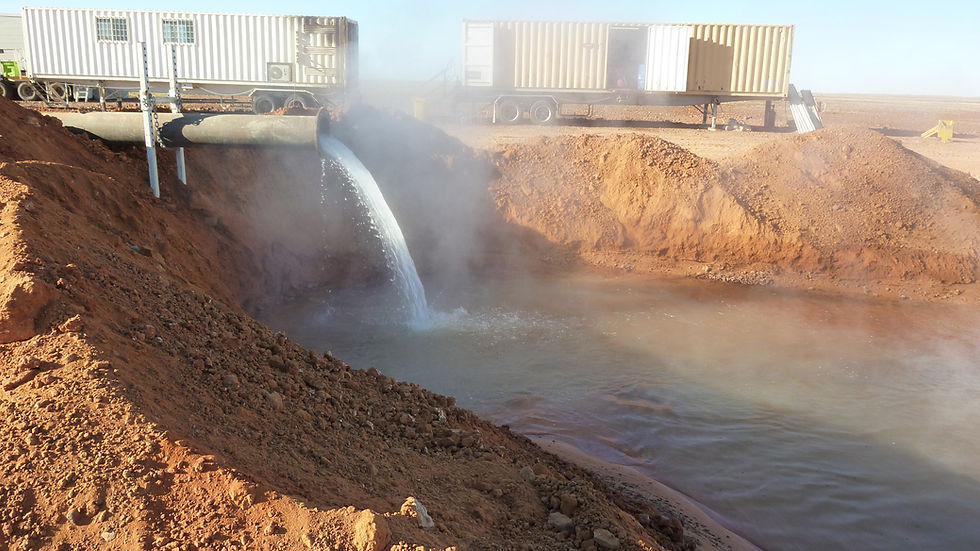Artesian Water Drilling Explained: Benefits & Challenges
- mastermcc3
- Aug 21
- 4 min read
Updated: Sep 27

Water is one of the most valuable resources in Australia, especially in rural and agricultural regions where surface supplies are limited. Among the various groundwater solutions available, artesian water drilling stands out as a reliable and high-yielding option. But what exactly is an artesian bore, and why is it so important for farmers, communities, and industries?
In this article, we’ll explain the basics of artesian water drilling, explore its benefits and applications, highlight the key challenges and risks, and provide practical advice for property owners considering this investment.
What is Artesian Water?
Artesian water comes from a confined aquifer—a layer of water trapped between impermeable rock or clay. Because it is under pressure, when drilled, the water can rise naturally to the surface without the need for pumping.
There are two main types of artesian bores:
Flowing Artesian Bore – water rises above ground level under natural pressure.
Sub-artesian Bore – water rises within the bore but requires a pump to reach the surface.
These bores are common across the Great Artesian Basin (GAB), which underlies 22% of Australia and supplies water for agriculture, livestock, and remote communities.
How Artesian Drilling Works
Drilling into an artesian aquifer is more complex than drilling a shallow domestic bore. The process generally involves:
Hydrogeological Survey – understanding the geology, depth, and pressure levels.
Specialised Drilling Rigs – deep drilling equipment capable of reaching confined aquifers, often more than 1,000 metres underground.
Casing and Cementing – installing protective steel casings and cement to maintain bore integrity.
Flow Management – ensuring water pressure is safely controlled to prevent uncontrolled discharges.
Completion and Maintenance – fitting the bore with appropriate headworks, valves, and monitoring systems.
Because artesian systems are high-pressure environments, drilling requires licensed professionals with advanced equipment and compliance with government regulations.
Benefits of Artesian Water Drilling
Artesian bores are a long-term water security investment for properties and industries. Some of the key benefits include:
1. Reliable Water Supply
Artesian aquifers provide large volumes of water, often at consistent rates, making them ideal for livestock, irrigation, mining, and town water supply.
2. Reduced Pumping Costs
Flowing artesian bores often deliver water under their own pressure, meaning no pumping equipment is required, which reduces operational costs and power consumption.
3. High-Quality Water
Many artesian systems produce clean, mineral-rich water that is suitable for domestic, agricultural, and industrial use (after testing for local conditions).
4. Support for Remote Areas
In arid regions with limited rainfall or surface water, artesian bores provide a lifeline for rural communities, enabling long-term settlement and agricultural activity.
5. Scalable Applications
From small stock bores to large-scale irrigation or industrial programs, artesian systems can be developed to suit a wide range of needs.
Challenges and Considerations
While the benefits are significant, artesian water drilling also comes with challenges that property owners should be aware of:
1. High Upfront Costs
Artesian drilling requires deep, specialised rigs and experienced crews. Costs can run into tens or even hundreds of thousands of dollars, depending on depth and geology.
2. Regulatory Requirements
Because artesian water is a shared and finite resource, drilling is tightly regulated. Owners must obtain permits, licences, and approvals from state water authorities.
3. Water Quality Variability
Some artesian bores produce water with high salinity or mineral content that may not be suitable for all purposes without treatment.
4. Sustainability Concerns
Uncontrolled or poorly maintained bores can waste large volumes of water and reduce pressure across the aquifer system. Programs like the Great Artesian Basin Sustainability Initiative (GABSI) emphasise responsible management.
5. Maintenance and Rehabilitation
Artesian bores must be regularly inspected to prevent leaks, casing corrosion, or uncontrolled flows. Bore rehabilitation may be required over time to maintain efficiency.
Artesian Water in Australia: Real-World Examples
Agriculture: Large cattle stations across Queensland and the Northern Territory rely on artesian bores for watering stock year-round.
Mining: Artesian water supports mineral exploration projects where no surface water exists.
Communities: Remote towns use artesian supplies for drinking water, supported by treatment systems to meet health standards.
Related Post: How to Choose the Right Bore for Your Property
Is an Artesian Bore Right for Your Property?
When deciding whether to invest in artesian drilling, consider the following:
Do you need a high-yield, long-term supply?
Is your property located over a known artesian basin?
Are you prepared for the upfront costs and compliance requirements?
Do you have expert drilling contractors to manage the project?
Working with an experienced provider ensures the bore is designed, drilled, and maintained for maximum efficiency and sustainability.
FAQs: Artesian Water Drilling
1. How deep is an artesian bore?
Artesian bores can range from a few hundred metres to over 1,600 metres deep, depending on local geology.
2. Can artesian water run out?
Yes. While the Great Artesian Basin is vast, excessive extraction or uncontrolled bores can reduce pressure and flow over time. Sustainable management is essential.
3. How much does artesian drilling cost?
Costs vary but typically range from $50,000 to $100,000+, depending on depth, geology, and equipment required.
4. Is artesian water safe to drink?
In many cases, yes, but testing is essential. Some artesian water may contain high levels of salts or minerals that require treatment.
5. Do I need a licence for an artesian bore?
Yes, in all Australian states, a licence or permit is required before drilling or operating an artesian bore.
Final Thoughts
Artesian water drilling provides a powerful solution for long-term water security, especially in Australia’s remote and arid regions. Its benefits include reliable supply, cost savings, and support for industries and communities. However, the challenges—such as cost, regulation, and sustainability—must be carefully managed.
By working with a licensed, experienced drilling contractor, property owners can ensure their artesian bore is safe, efficient, and compliant with environmental standards—delivering water security for decades to come.





Comments